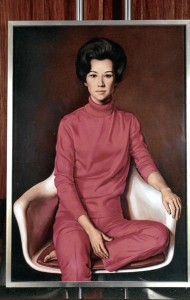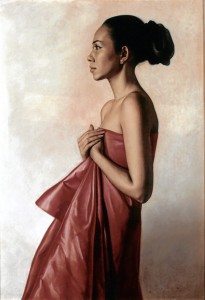
Not only in their imagination do artists take flight. Indeed, key artists travel outside their original geographies in search of new worlds, landscapes, colors and other people that can serve as essential stimuli for their art.
Gauguin sailed to Tahiti, Van Gogh to Arles in Provence. Delacroix and Matisse travelled to Morocco, Piet Mondrian to New York. Meanwhile Georgia O’Keefe sought the desert solitude of New Mexico.
Juvenal Sanso found his ideal landscape inspiration in Brittany. Even National Artist BenCab was a London expatriate for over a decade.
Regardless of the length of their stay in these distant places, these artists were, without exception, affected by another culture; in turn, these experiences markedly influenced their works.

In January 1968, Chilean-born, Madrid-based artist Claudio Bravo journeyed to Manila where he stayed for six months. Within that relatively short span of time, Bravo produced approximately 30 portraits of Manila’s prominent social figures. Collectively they were exhibited at the premier art space in town, Luz Gallery.
Ideas of identity
Since then, these portraits have never been seen by the public.
In retrospect, it is worth pondering the significance of that eventful year. In 1968, the Philippines was already in a state of social ferment. (In a few years, martial law would be declared). Europe was convulsed by student riots. Soviet Russia invaded Czechoslovakia; while in Poland, the citizenry revolted against the Communist government. Chile, too, was wracked by political violence, human-rights abuses, terrorism.
Against this global landscape of political strife and ideological turmoil, Bravo was the exemplar of the artist as human spirit, seeking solace through the grace of art.
Today, the Philippines and Chile have reclaimed their valued democracy. It is heartening that once, long ago, a Chilean artist spent time with Filipinos who, to this day, treasure the memory of his friendship through his art.
The show “Claudio Bravo: A Sojourn in Manila” opens on Sept. 18 at the Metropolitan Museum of Manila. It is a celebration of that one particular time, strengthening the cultural ties that bind the Philippines and Chile.
In her book “Portraiture,” Shearer West writes of the value of portraits:
“Portraits are not just likeness but works of art that engage with ideas of identity as they are perceived, represented and understood in different times and places. Identity can encompass the character, personality, social standing, relationships, profession, age and gender of the portrait subject. These qualities are not fixed but are expressive of the expectations and circumstances of the time when the portrait was made. These aspects of identity cannot be reproduced, but they can only be suggested or evoked.”
No need for photography
The discovery of photography which has usurped the mimetic function of painting has impelled artists to interpret their subject according to their own distinct and individual style.
Impressively Bravo never needed the assistance of photography. He was always requiring a series of sittings, at least for the rendition of the subject’s visage.
On these portraits, Bravo brought to bear the imprint of his unique gifts. Satisfying not only the fundamental requirement of mimesis—the likeness or verisimilitude of reality—his portraits are immensely enriched by his decisive but sensitive choices of pose, gesture, outfit, expression. The artist determined even the presence or absence of props.
Memorialization, of course, is at the very core of the art of portraiture. The pain of loss is salved and mediated by the genius of an artist. Thus the sitter’s absence in the physical world is now redeemed by these immaterial images.
This exhibition is a pictorial anthology of a vanished time in Philippine social history. To merely regard these portraits as the vanities of the privileged and the impeccably pedigreed is to miss out on their very real intrinsic aesthetic quality. Undoubtedly they are among the best specimens of the art of portraiture.
Testament to power and beauty
Four decades hence, Bravo’s portrait masterpieces remain as an immortal testament to the power and beauty of art, unbound by age, enriched by the passage of time.
In one remarkably touching passage from an interview, Bravo reminisced on his sojourn in Manila:
“I think the Philippine portraits are perhaps the most lucid paintings, because it was a different race, beautiful! Different colors, and I could paint with colors like Matisse. Philippines was the tropics, a different version of the world and of light…”
After his departure from the Philippines in 1968, Bravo would live and work in Tangier, Morocco, in 1972, later keeping other residences in Marrakech and Taroudant.
In succeeding decades, greater fame attended his international shows of classical interpretations of still lifes, human figures, packages, drapery, which were all imbued with the magical Bravo stamp: an almost hallucinatory realism in the Grand Manner, conceived in the classical vein, wrought with extreme elegance of composition, technically faultless, and seemingly haunted by a piercing silence.
Claudio Bravo passed away in 2011.
In connection with the National Day of Chile, “Claudio Bravo: Sojourn in Manila” will be opened formally at the Metropolitan Museum of Manila on Sept. 18, 6 p.m., by Chilean Ambassador Roberto L. Mayorga and Oscar M. Lopez of the Energy Development Corporation. Exhibit runs until Oct. 20.

